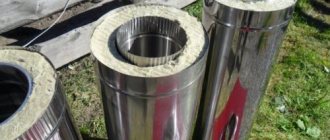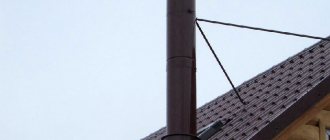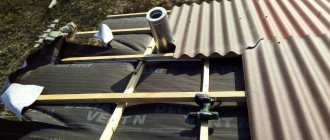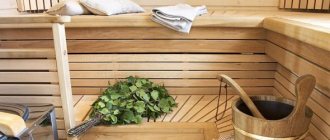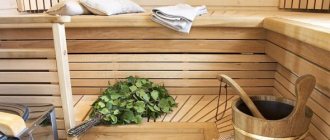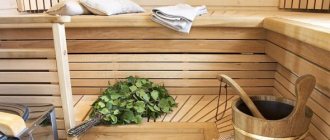Have a nice day!
If your home is not connected to a central heating system, you will have to install an individual heat-generating device. Whatever it is: a boiler, stove, fireplace or a complex consisting of several devices at once, you will have to think through the concept of removing fuel combustion products. And in this article we will tell you how to build a chimney from a steel pipe with your own hands.
Types and designs
Chimneys are made from the following types of steel:
- Alloyed (with and without enamel coating).
- Mirror stainless steel.
- Galvanized.
Steel chimneys come in 2 models:
- Single-walled (single-pipe).
Simple rigid or flexible corrugated pipes and shaped elements for them with a thickness of one wall (0.5 - 1.5 mm) can withstand heating up to 1100⁰C. Mainly used as liners in brick chimney shafts. They can also act as an independent structural element, but in this case it will be necessary to carry out additional work on their thermal insulation and insulation.
- Double-walled (two-pipe).
So-called sandwich or coaxial chimneys consist of two pipes of different diameters and, as a rule, different levels of heat resistance, inserted into one another. The space between them is filled with fire-resistant insulating material (most often basalt mineral wool), which performs several functions:
- Insulation of the pipeline when it is placed outdoors.
- Prevents condensation.
- Ensuring a normal level of traction.
They are distinguished by a longer period of operation, as well as originality and aesthetics, which eliminates the need to cover them with a decorative casing.
Chimneys also differ according to the type of structural solution:
- The location of the chimney circuit is inside or outside the room.
Placing a chimney in a house is a more labor-intensive process, which involves laying it through the ceilings and exiting through the roof. In many ways, this concept is justified by the high heat saving coefficient and the ability to arrange the simplest and most efficient straight, strictly vertical configuration. However, this method is the most fire hazardous; in addition, the pipe eats up useful space in the rooms through which it passes.
Exiting the pipe to the street through a hole in the wall of the house and attaching it to the facade using brackets significantly reduces the fire hazard index. However, in this case, additional work will be required to insulate the circuit, and in areas with severe frosts, it becomes necessary to construct an external brick shaft as a complementary insulating casing.
- According to the angle of inclination of the contour into: upright (strictly vertical), inclined and containing horizontal sections.
The first option is considered the most effective. Slopes and horizontal planes impair traction in the circuit, so their installation must be carried out in strict accordance with building regulations.
- The shape of chimneys can be round, oval, square and rectangular.
The best is considered to be a round cross-section, which has excellent aerodynamic characteristics. Square and rectangular formats help reduce the speed of movement of the air mass inside the contour due to the formation of turbulence in the corners. In addition, it is in the corners that more soot is deposited.
Advantages of metal chimneys
Metal smoke pipes, used as an alternative to brick chimneys, have a number of very tangible advantages.
Moreover, these advantages relate not only to the ease of production and installation, but also to the functioning of the entire heating system as a whole:
- Stainless steel chimneys weigh significantly less than brick chimneys, so a foundation is not required for their construction.
- Installation of metal chimneys into a single system is incomparable in complexity to the installation of traditional brick chimneys, and is a kind of “constructor” that can be assembled with even minor engineering skills.
- Also, the advantages that steel chimneys have include mechanical strength, corrosion resistance, and durability. If you choose a chimney from the right material (we will talk about choosing the grade of steel for pipes below), then the resulting system will have an almost unlimited service life.
- The circular cross-section of metal chimneys is optimal for removing flue gases from an aerodynamic point of view. The thing is that in a round pipe, unlike a square brick chimney, there are no local turbulences that impede the movement of gas in the pipe and reduce draft.
- The smooth walls of a metal chimney, unlike the walls of a brick chimney, do not accumulate soot. That is why the operating instructions for metal chimneys do not provide for their frequent cleaning.
Chimney corrosion
In addition, it should be noted the versatility of metal chimneys (they can be easily adapted to almost any heating device - as long as the pipe material allows it) and ease of installation in an already constructed building.
Thus, if you install a heating boiler or stove where it was not provided for by the building design, a metal chimney pipe is practically the only possible solution.
Advantages and disadvantages
Steel chimneys have many advantages:
- The smoothness of the inner walls minimizes soot settling.
- High strength characteristics and durability.
- Low weight of the structure and, as a result, no need to install a separate foundation platform.
- Aesthetics and the ability to implement any configuration solutions.
- Ease of installation and the ability to carry out installation work without the involvement of highly specialized professionals (assembly occurs according to the principle of a designer).
- Maintainability, ease of maintenance and care.
- Lowest price compared to chimneys made from other materials.
Of course, iron structures also have some disadvantages:
- Metal is prone to corrosion, so the formation of condensation in the circuit can shorten its service life.
- Long-term exposure to too high temperatures can lead to melting and burning of the pipe.
Fire safety requirements for chimneys
The distance from the surface of ceramic, insulated steel and asbestos-cement chimneys to combustible house structures must be at least 250 mm; for brick chimneys and sandwich pipe structures - at least 130 mm.
It is necessary to protect building structures made of combustible materials using cement or gypsum plaster on a mesh with a thickness of at least 25 mm.
If the roof covering can burn (roofing felt, bituminous tiles, ondulin), or leaves or fluff can accumulate on it, a mesh spark arrester must be installed on the roof cap.
Remember that the life and health of your loved ones depends on the quality of smoke removal.
Service life of a steel chimney
On average, the service life of steel smoke exhaust ducts is about 50 years. However, it should be noted that the characteristics of steel also determine the service life of the chimney:
- Galvanization is less resistant to corrosion. The formation of condensate inside a galvanized chimney inevitably reduces its “life” to 10-20 years.
- Stainless steel and especially durable alloy steel can last more than 100 years.
In addition, it is clear that the thicker the metal sheet, the longer the period of its operation.
Features of installation of steel chimneys
Preparing the chimney for installation
So, you have purchased a chimney of a suitable design and are ready to begin installing it.
However, before you start installing the chimney, you should perform several operations, which will subsequently significantly extend the life of the entire smoke exhaust system and have a positive impact on the quality of its work.
- Before assembling the chimney, all seams inside it are treated with a special sealant. The thing is that even the best metal rolling or welding cannot provide a 100% guarantee of tightness
- There is no point in applying sealant to the outside - sooner or later (more likely sooner) it will fall off, and it is irrational to re-seal the seams of an already working chimney.
Installation stages
Connecting the chimney to the boiler
Installation of stainless steel chimneys is carried out “from the bottom up”, i.e. The pipes that make up the chimney are mounted from the heating device (boiler, stove or fireplace) to the chimney on the roof of the building.
- The pipe links are assembled sequentially: each subsequent chimney pipe - steel or made of another material - is inserted into the previous one. This joining method protects the structure from condensation getting into the insulation.
- The pipes that make up the chimney are placed on top of each other to a depth that should be at least half the outer diameter of the pipe. This requirement is due to fire safety standards.
- We lay the working chimney channels along the walls or internal partitions. Naturally, all these structures must be made of non-combustible materials.
Note!
In order to ensure maximum tightness of the chimney and protect it from moisture, it is recommended to carry out additional treatment of the joints using sealant.
The optimal operating temperature of the sealant should be at least 1000 degrees.
Attaching the chimney to the wall
- The working joints of the chimney pipes are fixed with special clamps (most often they come complete with the chimney).
- Every one and a half two meters, a steel pipe used to construct a chimney - smoke or inspection - is fixed to the supporting structures using brackets. Each tee or bend is fixed with a separate bracket.
- Horizontal sections of the chimney require strict control: it is necessary to prevent their contact with gas pipes and electrical wiring.
In the lower part of the structure, for ease of cleaning the chimney during active use, a removable part is installed or a door is installed.
Insulation and arrangement of the chimney
Insulation of the chimney is mandatory if the chimney is located near the building to be insulated. The main purpose of insulating chimneys is to ensure their rapid heating and reduce the amount of condensate that falls.
It is also important that when chimneys are located in close proximity to combustible and flammable materials, the insulation often plays the role of additional fire protection.
To protect the outer chimney pipe from debris, moisture and atmospheric influences, it is recommended to use nets, deflectors and weather vanes.
Exiting the chimney to the outside
Naturally, this is only the most general information necessary for the correct installation of a chimney made of stainless steel pipes. However, even they will help you choose the steel chimney pipes that are suitable for your heating system, as well as install them correctly. After all, the operation of the entire heating system largely depends on this!
Did you like the article? Subscribe to our Yandex.Zen channel
Make it yourself or order it
It must be remembered that mistakes made during the installation process can result in the most unfavorable consequences - carbon monoxide poisoning and even fire. It is best to seek help from professionals, giving preference only to trusted companies.
However, one of the key advantages of steel chimney circuits is the ability to install it yourself. Moreover, even the pipes themselves can be made independently, which will significantly save the construction budget and select the most optimal diameter for the main line. If you have sufficient engineering and construction knowledge and skills and are ready to take responsibility for the functioning of the chimney, you can begin to independently implement the project.
Tips for choosing
When choosing a chimney duct, be guided by:
- The power of the heat generating device.
- The fuel on which it will run.
- The combustion temperature of the fuel and, accordingly, the flue gases.
- Pressure in the circuit.
- Type of firebox (with an open firebox, the heating temperature of the gases increases by 1.5 times).
- Heating mode (intensive operation of the heat generator can bring the temperature of the flue gases at the entrance to the circuit to 1000⁰C).
- The location of the chimney (inside or outside the building).
Which steel is better for a chimney?
Steel for chimney circuits must meet a number of requirements. It must be resistant to:
- High temperatures.
- Soot combustion.
- Moisture causing metal corrosion.
- Aggressive substances (acids and alkalis) formed in the pipe as a result of the chemical reaction of condensate and fuel combustion products.
Alloy steel, which contains chemical elements (chrome, copper, nickel, etc.) that improve the metal’s resistance to corrosion and destruction, has the best strength indicators.
Stainless steel is almost as strong as alloy steel, but is cheaper, so it is in greatest demand. Galvanization has an even lower cost, however, it is characterized by insufficient anti-corrosion resistance and requires careful insulation to prevent the occurrence of a sharp difference in temperature conditions, which causes the formation of condensation. In addition, galvanized steel is not heat-resistant enough, so it is used only in conjunction with gas equipment.
When choosing steel, you should be guided by the heat resistance coefficients of the material, which are set for each type of heat generator and type of fuel separately, depending on the efficiency. It can vary significantly between different brands of the same metal:
| Comparative characteristics of AISI stainless steel | |||||
| Brand | AISI 439 | AISI 304 | AISI 316 | AISI 310 | AISI 321 |
| Corrosion resistance | good | high | high | high | high |
| Working temperature | up to 600º C | up to 300º C | up to 450º C | up to 1000º C | up to 800º C |
| Gas | + | + | + | + | + |
| Wood | + | — | — | + | + |
| Coal | — | — | — | + | — |
| Liquid fuel | — | — | + | — | — |
| Peat briquettes | — | — | — | + | — |
How and with what to insulate
Non-flammable thermal insulation material in cylinders for chimney insulation
Insulation of the chimney is carried out both at the stage of its installation, if a single-wall steel pipe was chosen as the material, and after the construction of the structure. To insulate steel chimneys, non-flammable types of insulation are used: expanded clay, mineral and basalt wool.
When installing yourself, it is better to use basalt heat-insulating cylinders of the required cross-section and thickness. This is insulation in the form of a pipe with a longitudinal cut for easy installation. The insulation goes around the pipe along the contour and is fixed with metal ties.
The thickness of the insulation depends on the air temperature in winter and is selected individually for the specific type of chimney. For example, a heat-insulating cylinder from Rockwool with a thickness of 300 mm and a cross-section of 133 mm will cost 275 rubles per linear meter.
An alternative to cylinders is pierced mats - this is a similar in composition insulation in a roll, which during installation will have to be adjusted to the outer diameter of the chimney. Depending on the manufacturer, the mats have different sizes. For example, a stitching mat from TechnoNIKOL with dimensions of 2400x1200x40 will cost 970–1000 rubles per package.
Building regulations
Work on the arrangement of smoke channels must be carried out in accordance with the requirements of SNiP 2.04.05. If we are talking about gas equipment, you will have to familiarize yourself with the provisions of SNiP II-35.
Let us outline the main requirements:
- One heat generator - one chimney. Those. For each heating device (stove, fireplace, boiler) a separate smoke exhaust line must be installed.
- It is not allowed to lay a smoke exhaust duct near other utilities: electricity, water supply and gas pipelines. The distance between them must be at least 1.2 m.
- Absolute tightness of the circuit. This will not only eliminate the possibility of leakage of toxic carbon monoxide, but will also prevent the flame from escaping beyond the mine if soot accidentally ignites.
- Maximum verticality. A single slope of 30⁰ or 45⁰ is allowed with subsequent alignment of the smoke exhaust channel. If there is a need to lay a horizontal section, then its length should not exceed 1 meter.
- Mandatory installation of at least one inspection hatch.
- Thermal insulation of the channel must prevent the formation of a “dew point” (condensation) inside the pipeline.
- The height of the chimney contour is at least 5 meters, while the level of elevation of the pipe above the roof depends on the shape of the roof and the distance from the canopy.
- When venting a chimney through a façade wall, to determine its height, wind pressure zones formed by the environment (buildings, trees, terrain) should be taken into account.
Fire safety requirements for chimneys
All work must be carried out with the utmost care to ensure absolute safety of the circuit. Forbidden:
- Place connecting seams where the contour passes through the ceilings, walls and roof.
- Lay horizontal sections in the attic and arrange inspection and cleaning openings.
- Bring the chimney duct closer to building structures at a distance closer than 38 cm for wooden buildings and
Following fire safety requirements will make the chimney and your home absolutely reliable:
- When leading a pipe through a wall, a hole is cut with a minimum margin of 45 cm on each side. This hole is lined with an iron box or sandwich ring and filled with expanded clay or asbestos, and then closed with a lid made of fireproof material. This design helps prevent the wall from overheating.
- When the chimney is exhausted through the roof, a protective layer of galvanized steel and insulation is laid.
- When the chimney pipe passes close to the wall, the latter is finished with heat- and fire-resistant materials.
- The chimney should be equipped with a deflector with a fine-mesh spark arrester on top.
Traction force
The draft ensures the removal of combustion products through the chimney shaft to the outside. It is extremely important that this process be as natural as possible, which is facilitated by the correct geometry (configuration, diameter and height) and tightness of the entire smoke removal complex, as well as ensuring the flow of fresh air from the outside.
The first signals of problems with draft are difficulties with kindling, unstable behavior of the flame, its blowing out or smoke in the room. If the traction force is not working, operating the device is not safe and can lead to carbon monoxide poisoning.
The presented diagram illustrates the process of checking the draft force in a chimney:
The functioning of the draft is also influenced by weather conditions, the impact of which can be minimized by installing equipment for forced draft and a deflector at the pipe head.
Brick chimney
These chimneys have been known for a long time; they were used in the construction of stoves in village houses many years ago. There are 2 ways to make a chimney:
- On the stove - an easy option;
- Placed next to it and connected using an adapter.
The structure of brickwork is:
- working area - located below the ceiling;
- outer part - passing through the ceiling with fluff to the roof;
- neck with a head - a pipe passing through the roof equipped with an “otter”.
Such a chimney is a heavy device, and it is recommended to install it only if you have a brick stove.
To learn more about how to lay a brick chimney with your own hands, see this article.
Making and installing a chimney with your own hands
As we have already said, existing technologies allow you not only to install a chimney yourself, but also to make chimney pipes with your own hands. For this you will need:
- Metal suitable for the purpose.
- Metal scissors.
- Wooden or rubber mallet.
- Iron corner.
- Long strong ruler.
- “Cannon” is a machine that bends a sheet into a circle.
Stages of work:
- The metal sheet is marked and cut into strips of the required length and width.
- Then, using a mallet and an iron corner, the edges of the workpieces are bent in directions opposite to each other, first at a right angle (90⁰), then the bend angle is smoothly adjusted to 135-145⁰. Bend width – 0.7 mm.
- The workpiece is placed on the machine and, tapping with a rubber mallet, it is given the desired shape.
- The edges of the workpiece are interlocked. Place the workpiece on the machine again and flatten the seam joint with a mallet. For greater strength, the seams should be welded.
- To manufacture rotary elements, finished pipes are cut and welded at the desired angle (at least 90⁰):
- To obtain a 90⁰ turn, the pipes are cut at an angle of 45⁰.
- For a bend of 120⁰, the cut is made at an angle of 60⁰.
- For a 150⁰ turn, the pipes are cut at an angle of 75⁰.
Important. When installing, homemade pipes require mandatory insulation.
Drawing and diagrams
Before installation, it is necessary to prepare a design and diagram of the future chimney, which will help determine the required amount of material, and calculate in advance the length of the chimney as a whole and individual sections in particular.
Size calculation
- Determination of the cross-section and height of the chimney.
A pipe that is too thin will not be able to provide the required traction force, and in some cases may cause reverse draft and carbon monoxide emissions back into the room. An excessively large shaft diameter, on the contrary, leads to unreasonably high traction force, excessive fuel consumption and pointless energy losses.
The calculation is based on the power of the energy carrier. See the table:
The instructions for power plants indicate the diameter of the outlet pipe, which is taken as a basis in the first section of the circuit. Then the cross section can be changed depending on the calculated data.
Important: the more bends in the circuit, the larger the diameter of the smoke circuit.
- Determination of wall thickness:
- For gas equipment, the steel thickness is at least 0.5-0.6 mm.
- For liquid fuel installations - at least 0.8 mm.
- For solid fuel units – 1-1.5 mm.
Installation video
Watch the video in which an experienced stove maker will share his secrets with you.
https://www.youtube.com/watch?v=L4j8Bi2Ns68
Installation features
Installation of a metal chimney begins only after installation and careful fixation of the heating device. Assembly starts from the bottom, so first the element extending from the heat generator pipe is installed. Then a tee is fixed, the lower part of which acts as an inspection section and condensate drainage.
All seams are carefully treated with heat-resistant sealant, fastened with rivets and clamps, and then wrapped with aluminum tape. When joining sandwich pipes, to prevent condensation from entering the insulation, first the internal circuit is connected (the top is inserted into the bottom), then the external one. The depth of insertion of one pipe into another must be at least half the cross-section of the pipe itself.
The pipeline is fixed to the supporting elements of the house by installing brackets every 1.2 meters, a support platform, and clamps. In this case, the weight of the structure must be evenly distributed over all fastening elements. When the chimney pipe is raised above the roof by more than 1.5 meters, it must be secured with braces.
To ensure the optimal geometry of the steel chimney circuit and its maximum functionality, a variety of shaped elements are used:
- Turns.
- Adapters designed to change from one diameter (shape) to another.
- Tees and crosses that branch the circuit in different directions.
- Couplings (nipples) connecting individual sections of pipes to each other.
- Pass-through pipes and sleeves.
- Plugs, inspection modules, umbrellas, deflectors, aprons, caps, spark arresters, etc.
When a steel chimney is led out through the roof from the outside, the hole must be additionally sealed (closed) with a special sealing plug made of fire-resistant rubber or silicone.
At the end of the installation work, a test run is carried out, which allows you to check the tightness of the circuit and identify areas subject to excessive heating. Detected flaws are eliminated.
By the way, during the first start-up, an unpleasant burning smell may appear, which is a consequence of oil burning out from the surface of new pipes and crystallization of the sealant. There is no need to worry about this.
Calculation of the required cross-section and height of the pipe
To ensure good aerodynamics and adequate traction, it is necessary to comply with the rules prescribed in the relevant SNiP. They regulate the standards for the height and diameter of the pipe section for chimneys.
The height of the pipe depends on the type of roof. Its minimum possible value is 5 m, if measured from the heating device to the head. In addition, it is necessary to calculate the height of the part of the pipe protruding above the roof.
Above a flat roof, the pipe must rise no less than 50 cm. If the roof has a slope, the height of the pipe depends on its location in relation to the ridge of the roof. The location options are as follows:
- Up to 1.5 m from the ridge. In this case, the recommended pipe height is 50 cm higher than the most protruding part of the roof.
- From 1.5 to 3 m from the ridge. With this arrangement, the head should form a straight horizontal line with the roof ridge.
- More than 3m. In this case, the height of the protruding part of the pipe should be such that the angle between the ridge and the head is 10°. In this case, the pipe is located below the ridge.
Special formulas have been invented to calculate the cross section. They are very complex and to use them you need to know how much fuel is burned per hour of operation of the device, what the inlet and outlet temperatures are, as well as the coefficient for each type of fuel. To simplify the task of calculating the pipe cross-section, simplified rules are used:
- For devices with a power of less than 3500 W, the pipe cross-section must be at least 140 mm x 140 mm.
- For devices with a power from 3500 to 5000 W, the cross-section must be at least 140 mm x 200 mm.
- For devices with power from 5000 W to 7000 W - 140 mm x 270 mm.
We recommend that you read: How to install a heating cable for drainpipes?
Frequent errors and problems during installation
Numerous errors lead to inefficiency of both the chimney duct and the heating system as a whole. However, sometimes one miscalculation is enough for the problem to become fatal without proper attention: lack of proper traction force, reverse draft effect, smoke and carbon monoxide poisoning, and sometimes fire.
- Incorrect contour structure (exceeding the permissible slope values, horizontal passages, insufficient height, too large or small cross-section).
- Pinching of a steel pipe, leading to its deformation due to the properties of the metal to expand when heated. To prevent such situations, it is necessary to provide a small gap of 1-1.5 cm when fixing the lower part (the most heated during operation) or use special flexible clamps.
- Unsuitable steel type.
- Replacement of expanded clay block in the passage unit of floors and walls with basalt insulation.
Features of stove chimneys
The chimney is the most important part of the loop system, the correct operation of which directly determines the performance and efficiency of the stove. The operating cycle of such a system can be described as follows:
- Fuel combustion occurs in the firebox.
- During the combustion process, oxygen is processed, and corrosive gases are heated and removed through the chimney to the outside.
- When combustion products are removed from the firebox, an area of low pressure is formed, into which new portions of oxygen are drawn through the same chimney.
- The process is repeated again and again, until the fuel is completely burned.
Failure to comply with the chimney installation technology can cause a cycle disruption and provoke some unpleasant consequences:
- Irrational fuel consumption.
- Deterioration of heat transfer of the furnace.
- Increased fire hazard.
- Penetration of dangerous carbon monoxide into the living space.
Maintenance and cleaning
Inspection and cleaning of the chimney must be performed at least 2 times a year: before the start of the heating season and at its end. An external inspection is carried out, the tightness of the housing and the quality of the traction force are checked. Metal exposed to corrosion must be systematically painted with heat-resistant paint.
So the fuel, as a rule, does not burn completely, its residues in the form of soot and soot settle on the walls of the pipes, clogging them, reducing draft and increasing the risk of fire. You can even understand the degree of contamination of the mine visually, paying attention to the color of the smoke from the chimney: white indicates that everything is normal, black indicates the smoldering of soot residues in the circuit.
For cleaning, special brushes on rigid or flexible cables are used, sometimes with a steel ball at the end.
Before cleaning, stove makers recommend burning potato peelings in the firebox. The released vapors and potato starch soften soot deposits, thereby facilitating subsequent cleaning. Aspen firewood or special chemical compounds are often used for the same purpose.
Interference and obstacles
The process of smoke exiting the firebox can be prevented by the appearance of an area of high pressure, which, like a plug, will “plug” the chimney.
Cooled air in the chimney can become such an obstacle. That is why increasing the height of the chimney makes sense only up to a certain limit, beyond which each centimeter of height will not increase the draft, but decrease it.
Recommend: Is it possible to use one chimney for two columns
If the chimney has the required length, everything happens decorously and gracefully. But again, as long as all the particles of the air flow move at a relatively equal speed and in the same direction (this nature of the flow is called laminar).
Laminar and turbulent flow
But as soon as turbulence, or otherwise turbulence, arises, local zones of increased pressure appear in the chimney, which, under certain conditions, will impede the flow.
There is no ideal smooth flow; there will always be turbulence, for example, near the walls of the chimney, but if the transverse dimensions are small and (or) the walls have significant unevenness, the turbulence zone can occupy the entire cross-section of the chimney, weakening or completely blocking the draft.
Turbulence, redistribution of zones of high and low pressure, can not only reduce or completely destroy draft, but even cause a phenomenon called reverse draft, in which air begins to enter the firebox from the chimney side, pushing combustion products into the room.
Expert advice
- Give preference to vertical structures. Minimize the number of turns that reduce the aerodynamics of the contour.
- Choose pipes with a thicker wall, they will extend the “life” of your chimney.
- The first sections of pipes are subject to the greatest heating, which often damages the thermal insulation layer. In some cases, it is advisable to replace this area with a tank for heating water or a heater grid.
- To improve aerodynamic characteristics, every 10 meters the diameter of the pipe is reduced by 3 times.
- At the junctions of sandwich blocks, the insulation does not fit tightly enough, which leads to overheating of the circuit in these areas. The problem can be solved by installing an additional layer of insulation in these places yourself.
How to insulate
A rapidly cooling chimney causes a decrease in draft force and the formation of condensation, which leads to corrosion and gradual destruction of the pipe. The insulation works on the principle of a thermos.
And if coaxial chimneys are immediately made with insulation inside, then single-wall chimneys will have to be insulated yourself. Most often, fire-resistant basalt wool or fabric is used for this, which is wrapped around the pipe in 2-3 layers and secured with iron clamps or steel wire. Waterproofing is laid between layers of wool. The structure is topped with a stainless steel or galvanized box.
How the chimney works
The main part of any chimney is a vertical pipe structure. Structurally, the familiar brick stationary box differs from modern prefabricated counterparts made from ready-made factory-made modules.
A traditional brick pipe includes the following elements: a neck for connecting to the furnace, a riser with valves, a slope, an otter, a neck (at the point of passage through the roof), a headband, and sometimes a metal cap.
Homemade chimneys made of metal or asbestos cement include pipes, caps, adapters for connecting to the stove, and insulation.
The most modern types of chimneys are ceramic and three-layer sandwich pipes. The ceramic structure consists of an external expanded clay concrete frame, an internal prefabricated ceramic pipe, and a layer of insulation between them. The ceramic and sandwich structure itself includes the following blocks: straight blocks for collecting condensate, tees, modules for cleaning, transition elements for connecting heating units. An integral part of a modern chimney is the deflector.
